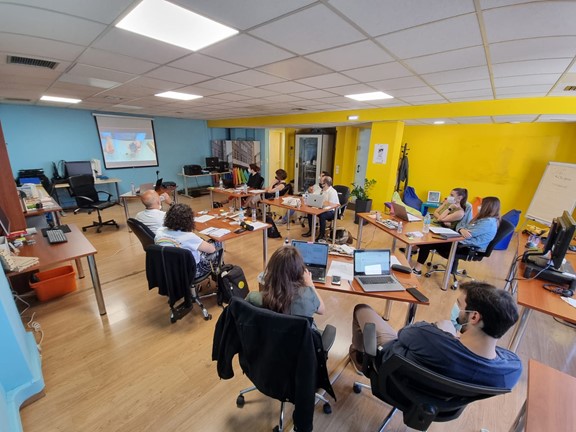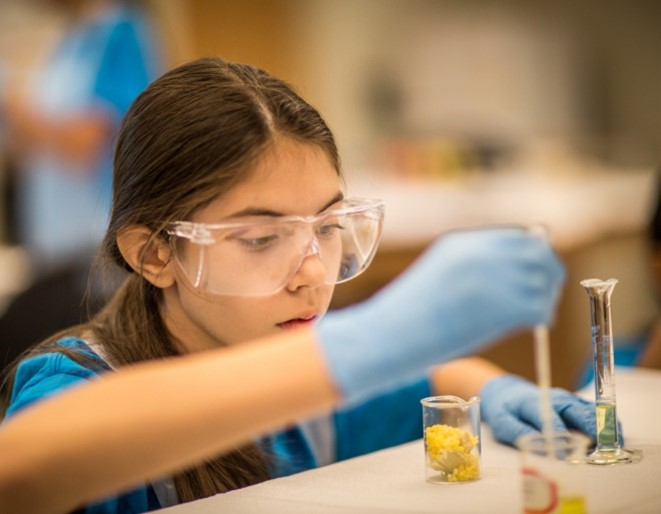Our Blog
2nd Transnational Project Meeting
Athens, Greece
8 October 2021
AKNOW (Asserted Knowledge) hosted the TPM2 meeting for the PhysicsKIT4STEM as the fourth day of the LTTA event at its headquarters in Athens, Greece.
The partners involved in the project (ECAM, PISTES, AKNOW, ATERMON, SCHOLE and EMPHASYS) participated in the event both physically and virtually.
The busy day-agenda included many activities that were shared between the project partners.

The day started with the PhysicsKit educational backpack, where the glossary and online repository were presented. The glossary was created so that there is a consolidated document with all glossary terms used in the curriculum as well as in the PhysicsKIT assembly guide. On the contrary, the idea for the repository is to have a list with extra resources for reading or experimenting which will complement the curriculum, the kit and other material that are developed further.
The event moved on to designing and building the PhysicsKit and localization of the project.
Then the presentation had a special module dedicated to PhysicsKIT Educators Handbook & Skills and Achievements Framework. The main outcomes from those two included two parts, the educator’s handbook and the skills and achievements recognition framework based on the Open Badges.
The partners shared their views and outputs and finalized the materials for the project.
After a busy morning schedules, all partners did enjoy a lovely lunch break and then came back together to discuss the final topics of the TPM 2.
Those topics were about Instructional Design, Content Transcription and LME Development.

Following the LTTA, all partners will start working on the re-purposing and remodelling of the training course inside the PhysicsKIT Learning Portal as an interactive multimedia content infused with digital resources.
A dedicated instance of the Learning Portal will be deployed on a fast infrastructure to support the project and the PhysicsKIT workgroup will be created as virtual space for the project stakeholders and learners.
Finally, every partner evaluated the overall experience of both LTTA and TPM and necessary feedback was given for future reference.
Overall, the partners were satisfied with the flow of the project and promised to meet soon for the updated version of PhysicsKIT4STEM.
Learning Teaching Training Activity (LTTA)
Athens, Greece
5 - 7 October 2021
AKNOW (Asserted Knowledge) hosted the LLTA meeting for the PhysicsKIT4STEM for 3 consecutive days in its headquarters in Athens, Greece.
The partners involved in the project (ECAM, PISTES, AKNOW, ATERMON, SCHOLE and EMPHASYS) participated in the event both physically and virtually.
On the first day on the 5th of October, the partners received a general presentation concerning the main areas of the project such as 1)Update on the finalised and ongoing tasks, goals of the project and important deliverables 2)Discussion about goals of the LTTA (proposal), adaptation to the current situation and avancement of the project. 3)Introduction to the outputs participants will be using during the 3-days training event.

They received their IO1 PhysicsKit educational backpack and also the Guide for Assembly and Configuration, where there was a review of the visual guide depicting the steps needed for assembling and configuring the PhysicsKIT and its components for teachers/pupils to be able to build it in the classroom.
Later on the partners were trained on how to assemble the PhysicsKIT and electronics kits using the guide.They were also introduced the Raspberry Pi and how to use the GPIO by connecting a series of sensors to the Raspberry using a breadboard.

For the next two days, the PhysicsKit Curriculum Design and Development was reviewed in the classroom with sensors, electronic components and peripherals to teach physics and perform experiments.
Following they reviewed and completed all the glossary of terms, keywords and expressions that are used in physics, electronics, programming, physical computing, but also in developing and building constructs.
Everyone was very interested in the project outcomes and shared their valuable feedback with the rest of the partners. What followed the theoretical part, was a display of each partner’s electronic kits and how they can be used in the context of the teaching process to enhance understanding of physics concepts, demonstrate programming constructs, and comprehend physics subjects.
Every partner presented one module and covered the four main topics which were:
- Primary content overview
- Lesson plans
- Learning outcomes
- Experiments

On the last day of the LTTA meeting all partners were delighted with the main outcomes of the project and how the process is evolving. They really enjoyed sunny Athens and its beautiful corners under the Acropolis and promised to renew their appointment very soon.
The Gender Gap
If you were asked to draw a picture of a scientist on a piece of paper would the character be male or female? The truth is that majority of people would draw a male scientist as social norms and stereotypes tend to describe science-related subjects and occupations as masculine.
Although actions have been taken during the last decade to eliminate the under-representation of women in science, technology, engineering and mathematics (STEM) education, a big gap is still present today and especially in the participation of women in STEM-related jobs.

Image 1: https://www.aauw.org/resources/research/the-stem-gap/
Even though the percentage of female researchers has increased worldwide, they are less likely to collaborate internationally and have a lot less academic publications than male researchers. Additionally, findings retrieved from Eurostat show that in Europe, out of the total number of scientists and engineers only 40% are women. There is an existent gender imbalance in the fields of mathematics and manufacturing employment sectors globally. Overall, the number of employed female scientists is still significantly low all over the world compared to men.
The Impact of the Gender Gap on Girls and Women
Women and girls in STEM are still being excluded from fully participating in this field. The quality of their education and the subjects they study are influenced by biases, stereotypes and sexism. Most women lack motivation in pursuing STEM careers because they fear that they would not be taken seriously in such positions and that they would not get the same opportunities as their male colleagues. Other reasons that have been reported for the low participation of women in STEM job positions include hostile and sexist work environments, the assignment of boring tasks, pay gaps and absence of career development and recognition. Moreover, findings from other studies indicate that gender-science stereotypes negatively influence women’s ambitions to enrol in STEM-related courses at university.
Gender Equality in STEM education & Economic Growth
According to the European Institute for Gender Equality, the need for STEM professionals is expected to increase up to 8% by 2025 and employment in STEM-related positions about 6.5%. Thus, the continuous under-representation of women in STEM will result in loss of talent and will go against the EU’s development potential. Reducing the gender gap in STEM education areas could help foster economic growth via both higher productivity and increased labour market activity.
“By advancing women’s equality, $12 trillion could be added to global GDP by 2025” - Dharmendra Kanani, Director of Insights at Friends of Europe
Increasing the participation of women in STEM subjects will have a strong positive GDP impact at EU level. More specifically it would contribute to an increase in EU GDP per capita by 2.2 to 3.0% in 2050.

Image 2: https://www.pexels.com/photo/portrait-of-female-chemical-engineer-in-laboratory-3861463/
On the 11th of February, the United Nations celebrated the International Day of Women and Girls in Science. The United Nations advocate that “science and gender equality are both vital for the achievement of the internationally agreed development goals, including the 2030 Agenda for Sustainable Development.”
PhysicsKIT4STEM to the rescue
The Erasmus+ project PhysicsKIT4STEM aims to foster the interest of children aged 11-15 in science. PhysicsKIT4STEM specifically addresses the issue of gender imbalance in STEM classrooms and aims to encourage young girls to get involved in science and engineering subjects. The project provides teachers with a hands-on approach to teach physics through DIY kits, electronics and programming, powered by a Raspberry Pi computer.

The main objective of the project will be achieved through the following activities:
- Design and development of a curriculum for using the PhysicsKIT to teach students physics concepts such as motion and forces, gravity, vibration and electricity, through the creation of hands-on constructions, simple programming and physical computing;
- Elaborate a Glossary, explaining terms used in physics, programming, electronics and physical computing;
- Design and development of the PhysicsKIT powered by a Raspberry Pi single-board computer, complemented by sensors and electronics to simulate and experiment on physics phenomena along with a guide to build it;
- Lesson plans that will support the curriculum to build kits and use peripherals in an educational hands-on play approach;
- Prepare a Learning Motivation Environment for the delivery of the curriculum to teachers/educators and for skills retention purposes;
- Testing, validation and finalisation of the PhysicsKIT Back-pack and Educators Handbook and Resources;
- Support the final outcomes through a dedicated virtual space (PhysicKIT Club) providing access to all project results and infrastructure for supporting the growth of a community of adopters/practitioners/enthusiasts.
Visit the PhysicsKIT4STEM website and Facebook page for more information and news related to the project:
Website: https://physicskit4stem.eu/
Facebook page: https://www.facebook.com/physicskit4stem
References
- How gender equality in STEM education leads to economic growth - https://eige.europa.eu/gender-mainstreaming/policy-areas/economic-and-financial-affairs/economic-benefits-gender-equality/stem
- International Day of Women and Girls in Science: How can we promote gender equality in STEM - https://gearingroles.eu/international-day-of-women-and-girls-in-science-how-can-we-promote-gender-equality-in-stem/
- Quote - https://www.friendsofeurope.org/events/women-in-stem/
- Image 1 & Information - The STEM Gap: Women and Girls in Science, Technology, Engineering and Math: https://www.aauw.org/resources/research/the-stem-gap/
- Image 2 - https://www.pexels.com/photo/portrait-of-female-chemical-engineer-in-laboratory-3861463/
